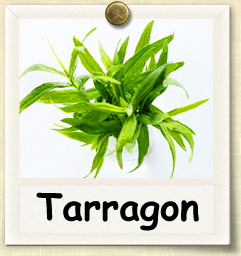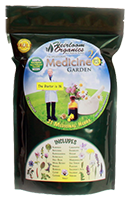|
Home > Guides > Herbs > Tarragon |
|
How to Grow Tarragon | Guide to Growing Tarragon |
|
|
|
|
| |
 |
|
Overview |
|
|
|
|
|
| |
|
| |
A hardy and vigorous plant, spreading at the roots and growing over a meter tall. Russian Tarragon actually prefers poor soils and happily tolerates drought and neglect. It is not as strongly aromatic and flavorsome as its French cousin, but it produces many more leaves from early spring onwards that are mild and good in salads and cooked food. Tasting somewhat like Anise, Tarragon is mildly sweet and adds excellent flavor to sauces, soups, vegetables and even desserts. The young stems in early spring can be cooked as an asparagus substitute. Grow indoors from seed and plant out in the summer. Spreading plant can be divided easily. |
|
| |
|
|
| |
|
|
| |
|
|
|
|
|
|
|
|
|
Well-drained, fertile soil |
|
|
|
|
|
|
|
|
|
|
|
|
Growing Guide
GROWING NOTES
Tarragon is a perenial that will die back in winter and is among the first herbs up in spring.
Tarragon seeds naturally show lower germination rates than other seeds, so are best started indoors in flats and transplanted outside once the last threat of frost has passed and evening temperatures exceed 55 degrees Fahrenheit. Start approximately 4-6 weeks before the last frost, and do not tranplant until first true set of leaves have developed and plant has reached a height of approximately 4 inches. Be sure to provide plenty of water to seeds as you await germination, and Tarragon will grow best with full sun, and prefers light, sandy, well-drained soil with a pH between 6.0 and 7.5.
MAINTAINING
Once established, Tarragon can succeed in less than ideal conditions, surviving and even thriving with variable light conditions, poor soil and limited water. Water immediately in the case of wilting or heat stress.
Tarragon is sensitive to root rot if left out over winter. To protect, cover with a layer of mulch in fall once aerial portions (parts above ground) have started to die off.
|
|
| |
|
| |
Heirloom seeds are the gardeners choice for seed-saving from year-to-year. Learning to save seeds is easy and fun with these books. Before you harvest, consider which varieties you might want to save seeds from so that your harvesting practice includes plants chosen for seed saving. Be sure to check out our newest seed packs, available now from Heirloom Organics. The Super Food Garden is the most nutrient dense garden you can build and everything you need is right here in one pack. The Genesis Garden s a very popular Bible Garden collection. The Three Sisters Garden was the first example of companion planting in Native American culture. See all of our brand-new seed pack offerings in our store.
|
|
| |
|
|
| |
Harvesting Guide
HARVESTING
The leaves are best collected in the early morning or evening, as collection in the middle of the day can result in mushy,wilting, less flavorful leaves. To cut, us a snip or garden shears and remove branch tips. If drying in quantity, take whole branch.
SAVING SEEDS
|
|
| |
|
|
|
| |
|
|
|
|
|
| You can find this variety in the following Seed Packs: |
|
 |
|
| Click the packs below to see some of our other wonderful products |
|
|
|
|
|
|
|